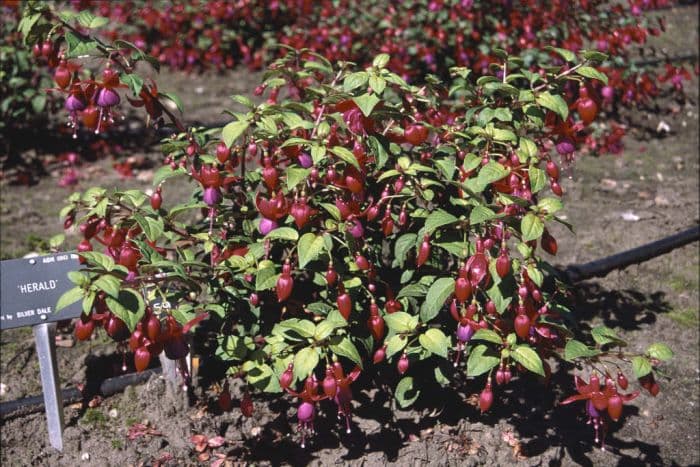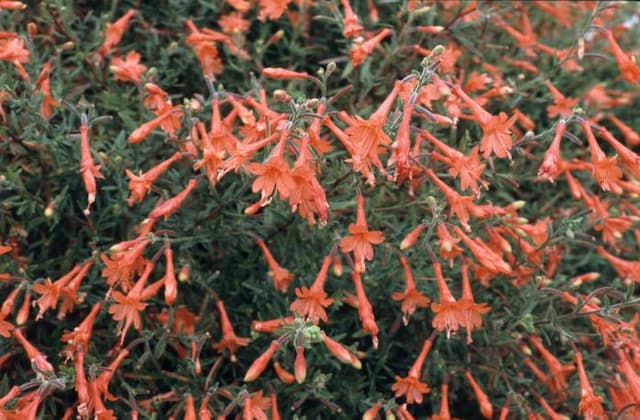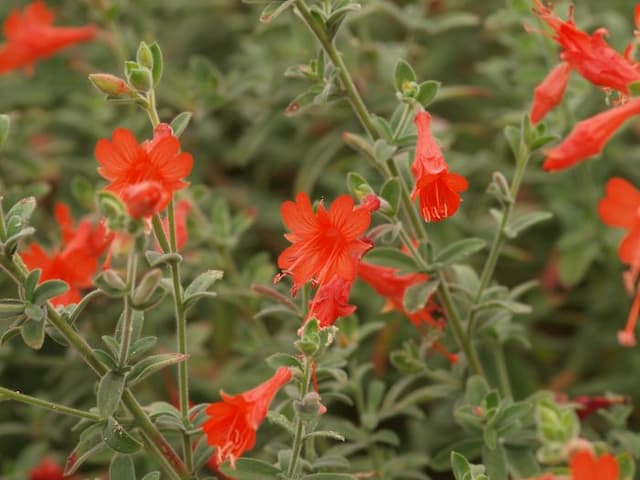Fuchsia Fuchsia 'Herald'

ABOUT
Fuchsia 'Herald' is a striking plant recognized for its distinctive and ornamental flowers. The blossoms display a fascinating color combination, with the gracefully elongated petals often a vivid shade of pink to purple. These tubular petals encase the delicate, inner structures which can be a deep purple to bright magenta, creating a delightful contrast that is eye-catching. The flowers typically dangle from the stems, resembling lanterns, adding movement and elegance to the plant's overall appearance. The foliage of the Fuchsia 'Herald' provides a lush backdrop for the vibrant flowers, with leaves that are usually a rich shade of green. These leaves are arranged oppositely along the stems and can have a slightly serrated edge, adding texture to the foliage. The stems themselves are often slender and may arch gracefully under the weight of the flowers, enhancing the plant's cascading effect. In a garden setting, Fuchsia 'Herald' can be a visual magnet due to its attractive flowers and foliage, which offer a striking contrast and depth. Although the specific size of the plant is not discussed, it's notable that regardless of its dimensions, the Fuchsia 'Herald' can be a central feature in gardens and containers where its floral display can be admired. It is an ornamental delight that brings beauty and sophistication to where it grows.
About this plant
 Names
NamesSynonyms
Herald Fuchsia, Ladies' Eardrops
Common names
Fuchsia 'Herald'.
 Toxicity
ToxicityTo humans
Fuchsia 'Herald', commonly known as Fuchsia, is generally considered non-toxic to humans. There is no widespread evidence that suggests serious toxicity in humans upon ingesting parts of the Fuchsia plant. However, ingesting any non-food plants can potentially cause mild digestive discomfort due to the presence of unfamiliar compounds, so it is always advisable to avoid consuming plant parts unless they are known to be edible.
To pets
Fuchsia 'Herald', commonly known as Fuchsia, is generally recognized as non-toxic to pets, including cats and dogs. The ingestion of this plant is not known to cause serious harm to pets. Nevertheless, as with ingestion by humans, eating non-food plants can sometimes result in mild gastrointestinal upset for pets, such as vomiting or diarrhea. If a pet consumes a large amount of the plant and shows signs of distress, it is advisable to consult a veterinarian.
 Characteristics
CharacteristicsLife cycle
Perennials
Foliage type
Deciduous
Color of leaves
Green
Flower color
Mixed
Height
1 foot (30 cm)
Spread
2 feet (60 cm)
Plant type
Shrub
Hardiness zones
9
Native area
Central America
Benefits
 General Benefits
General Benefits- Attracts Pollinators: Fuchsia 'Herald' is known to attract bees, butterflies, and hummingbirds, which are beneficial for pollination in the garden.
- Ornamental Appeal: With its beautiful pendulous flowers and vibrant colors, it adds aesthetic value and visual interest to any garden or landscape.
- Versatility in Landscaping: Can be grown in hanging baskets, containers, or as a bedding plant, offering flexibility in garden design.
- Shade Tolerance: Capable of thriving in partial shade, providing a flowering option for less sunny areas of a garden.
- Long Blooming Season: Provides a long period of flowering, generally from late spring to fall, for a continuous display of color.
 Medical Properties
Medical PropertiesThis plant is not used for medical purposes.
 Air-purifying Qualities
Air-purifying QualitiesThis plant is not specifically known for air purifying qualities.
 Other Uses
Other Uses```html
- Ink Production: The vivid hues of a Fuchsia 'Herald' can be extracted and used in the creation of natural dyes for artwork or fabric coloring.
- Culinary Garnish: The decorative blooms of the Fuchsia can be used as an edible garnish for salads and desserts, adding a splash of color and a mildly tangy flavor.
- Photography Subject: With its striking appearance, Fuchsia is often used as a subject for botanical photography and art, providing stunning visual material.
- Fairy Gardens: Due to its enchanting look, Fuchsia can be incorporated into fairy gardens for a fanciful and whimsical touch.
- Educational Tool: Fuchsia plants can be used in educational settings such as schools or botanical workshops to teach students about plant biology and hybridization.
- Theme Gardens: Fuchsias can be used in theme gardens, especially Victorian-themed spaces, given their popularity and extensive cultivation during the Victorian era.
- Live Jewelry: The blooms and leaves of Fuchsia can be carefully crafted into live jewelry pieces like earrings or hairpins for special occasions.
- Bonsai: With careful pruning and training, Fuchsia 'Herald' can be grown as a bonsai plant, offering a unique form of this typically bushy plant.
- Craft Projects: The flowers and foliage of the Fuchsia can be used in craft projects such as pressed flower art or in the creation of natural potpourri.
- Butterfly Gardens: Fuchsia 'Herald' attracts pollinators like hummingbirds and butterflies, thus playing a crucial role in their conservation by providing a nourishing habitat.
Interesting Facts
 Feng Shui
Feng ShuiThe Fuchsia is not used in Feng Shui practice.
 Zodiac Sign Compitability
Zodiac Sign CompitabilityThe Fuchsia is not used in astrology practice.
 Plant Symbolism
Plant Symbolism- Grace - Fuchsia flowers, with their delicate hanging blooms, are often associated with grace and elegance.
- Good Taste - The unique and ornate appearance of the Fuchsia represents refinement and good taste.
- Confiding Love - Historically, Fuchsia blooms have been symbolic of confiding love, possibly due to their heart-shaped flowers.
- Ambiguity - The dual-colored petals of some Fuchsia varieties can represent ambiguity and sometimes, a blending of opposite values.
 Water
WaterFuchsias, including the 'Herald' variety, require consistent moisture without being waterlogged. Water them when the top inch of the soil feels dry, which could be every couple of days during the warm season or less frequently during cooler months. Aim to provide enough water to keep the soil evenly moist, which might be approximately 1 to 2 gallons per week depending on weather conditions and plant size. Use a watering can or hose with a gentle nozzle to water at the base of the plant, avoiding wetting the foliage to reduce the risk of disease.
 Light
LightFuchsias like 'Herald' prefer bright but indirect light. An ideal spot is one that receives morning sunlight and shade during the intense afternoon hours. Depending on the climate, dappled sunlight beneath a tree or a position on a north or east-facing balcony or patio can offer the best lighting conditions for these plants to thrive.
 Temperature
TemperatureThe 'Herald' Fuchsia flourishes in cool to moderate temperatures, ideally between 55°F and 75°F. It can survive short periods down to 40°F but should be protected from frost. During hot summers, Fuchsias need protection from temperatures exceeding 76°F, particularly in the afternoon, to prevent heat stress.
 Pruning
PruningPrune the 'Herald' Fuchsia to maintain its shape, encourage bushier growth, and promote abundant flowering. The best time for pruning is late winter or early spring before new growth begins. Remove dead or weak branches and trim the plant to your desired shape. Repeat light pruning throughout the growing season to remove faded flowers and seed pods, which encourages continuous blooming.
 Cleaning
CleaningAs needed
 Soil
SoilFuchsia 'Herald', commonly known as Fuchsia, thrives in a well-draining, humus-rich potting mix with a pH between 6 and 7. A mix of 1 part peat, 1 part perlite, and 1 part loam is ideal. Ensure adequate organic matter for nutrition and moisture retention.
 Repotting
RepottingFuchsia 'Herald' should be repotted annually in spring to encourage growth and flowering. If the plant becomes root-bound or the soil appears exhausted, repotting may be necessary.
 Humidity & Misting
Humidity & MistingFuchsia 'Herald' requires high humidity levels, ideally between 60-70%. This mimics the plant's native habitat and encourages healthy growth and flowering.
 Suitable locations
Suitable locationsIndoor
Place Fuchsia 'Herald' in bright, indirect light with high humidity.
Outdoor
Hang Fuchsia 'Herald' in dappled shade, protect from frost.
Hardiness zone
9-11 USDA
 Life cycle
Life cycleFuchsia 'Herald', also known as hardy fuchsia, begins its life as a seed that germinates in warm, moist soil conditions. Upon sprouting, the seedling emerges and develops into a young plant with characteristic fuchsia leaves. As the plant matures, it enters the vegetative stage, growing stems and foliage while establishing a robust root system. The next phase is the flowering stage, where the hardy fuchsia produces its distinctive hanging blooms, typically in shades of pink, purple, and white, which can attract pollinators such as bees and hummingbirds. After pollination, the flowers develop into small fruit-bearing structures with seeds, completing the reproductive cycle. In temperate climates, the hardy fuchsia may enter a dormant period during colder months before resuming growth in the spring.
 Propogation
PropogationPropogation time
Spring-Early Summer
Fuchsia 'Herald', commonly known as a type of Lady's Eardrops, is most popularly propagated through softwood cuttings. This method is usually undertaken during spring or early summer, when the plant is actively growing. To do so, a gardener would cut a 2 to 4 inch (5 to 10 cm) length of stem just above a leaf joint or node, making sure the cutting includes a few pairs of leaves. The bottom set of leaves is removed, and the cut end may be dipped in rooting hormone powder to encourage root growth. The prepared cutting is then inserted into a moist potting mix and kept under high humidity, with some bottom heat to encourage rooting. Within a few weeks, the cuttings should develop roots and can eventually be planted out or potted up individually.









